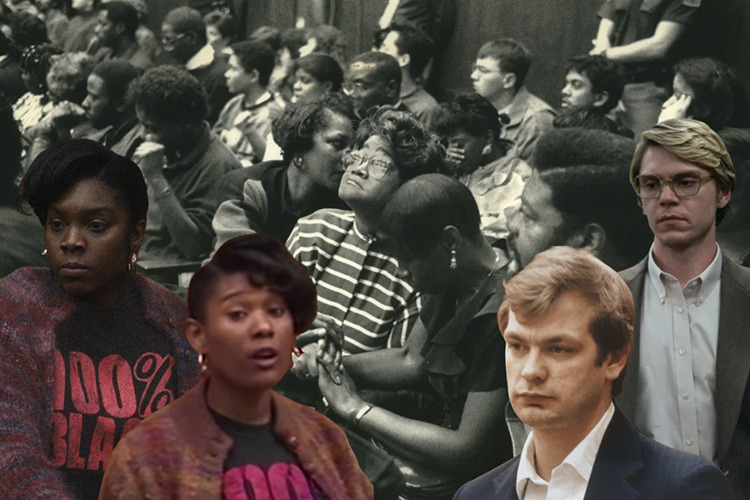
From front to back: the real Dahmer and Isbell, actors portraying Dahmer and Isbell, and members of the community that attended Dahmer’s court case. graphic by Shana Saint-Phard
The real focus in the new Dahmer series should have been on the victims whose lives he stole and the families that he forever broke.
Steven Hicks was 18 years old. He had recently graduated high school in Coventry Township, Ohio, and was hitchhiking to a rock concert in Chippewa Lake Park, only 25 miles away from his home, when a man spotted him on the side of the road. Hicks was a deeply caring person; his father, when interviewed, recalled a time when he took his son hunting. On this excursion, Hicks shot a rabbit and burst into tears when he realized what he had done.
Errol Lindsey was a mama’s boy. He was artistic and kind and hardworking and everyone in his life adored him. He had a sister, Rita Isbell, who said that she would “stand for him until [her] last breath.” He was a goofball and made everyone around him laugh. He left behind an unborn daughter, who is now 31 years old and a mother herself.
Those are just two of Jeffrey Dahmer’s 17 victims. Those small, surface-level facts about them won’t even begin to allow anyone to fully comprehend the losses that their families faced and the trauma that they went through. The new Netflix show, Dahmer – Monster: The Jeffrey Dahmer Story, though it claims to focus on the victims, spends barely any time with anyone besides Dahmer. The most disturbing thing about the show, however, is the fact that the producers did not ask for the consent of the families before portraying their characters and families for millions to watch greedily. The story of Dahmer and his victims is all public record, which is the only reason why, legally, Netflix was able to air the show without consent of the family. However, the show has faced a lot of harsh criticism from family members of the victims as well as people empathetic towards their situation. Isbell, Lindsey’s sister, for example, was “bothered” by the portrayal of herself on the screen. “If I didn’t know any better, I would’ve thought it was me,” said Isbell. “Her hair was like mine, she had on the same clothes. That’s why it felt like reliving it all over again. It brought back all the emotions I was feeling back then.” The show is, according to Isbell, retraumatizing her family over and over again. The popularity of true crime and the increasing demand for it also contributes to the trauma the families of Dahmer’s victims must experience- the series skyrocketed to become one of the most viewed on Netflix. Approximately 56 million households watched the series, funneling dollar after dollar to the producers and allowing them to make a fortune on the backs of the families that Dahmer emotionally scarred.
Dahmer’s portrayal in the show also inspired harsh criticism from viewers across the country. The discourse on social media about the show has largely romanticized the despicable acts that Dahmer committed, users going so far as to even defend his character, stating that, “One thing [they] found intriguing about [Dahmer] was that he was completely honest and didn’t deny anything.” Social media users have also created popular songs and used show footage to inspire comments about the attractiveness of the actor that portrayed Dahmer throughout the series. Some people have even joked about not being able to watch the show due to its gory nature, while others have reacted saying that the show wasn’t gruesome enough. Regardless of the true intentions of the show, the show’s legacy will not be that it helped honor the memories of the victims or brought to life the horror that their families experienced – the legacy it leaves behind will be one of rejection and disdain due to the disturbing reception of the show on social media and by the families of Dahmer’s victims.